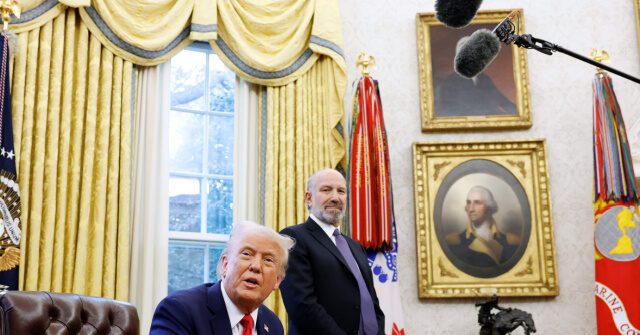President Donald Trump signed a memorandum Thursday announcing that he would introduce a plan to impose reciprocal tariffs on all countries that tariff U.S. exports.
Trump discussed the memorandum, which notes he “will introduce the ‘Fair and Reciprocal Plan,’” while flanked by his nominee for Commerce secretary, Howard Lutnick, in the Oval Office. The move came just hours before he was set to meet with Indian Prime Minister Narendra Modi.
“On trade, I have decided, for purposes of fairness, that I will charge a reciprocal tariff, meaning whatever countries charge the United States of America, we will charge them. No more, no less,” Trump said in the Oval Office.
“In other words, they charge us a tax or tariff, and we charge them the exact same tax or tariff,” he added.
Trump added that other countries charge “vastly more” in tariffs and taxes on U.S. goods than America charges in tariffs for their goods “in almost all cases.”
“But those days are over,” he added.
The memo itself notes:
It is the policy of the United States to reduce our large and persistent annual trade deficit in goods and to address other unfair and unbalanced aspects of our trade with foreign trading partners. In pursuit of this policy, I will introduce the “Fair and Reciprocal Plan”(Plan). Under the Plan, my Administration will work strenuously to counter non-reciprocal trading arrangements with trading partners by determining the equivalent of a reciprocal tariff with respect to each foreign trading partner.
A White House fact sheet on the memo, reviewed by Breitbart News, states that the “plan will put the American worker first, improve our competitiveness in every area of industry, reduce our trade deficit, and bolster our economic and national security. “
The administration provided several examples of trade imbalances. For instance, Brazil charges an 18 percent tariff on ethanol imported from the U.S., while the U.S. has a 2.5 percent tariff on ethanol imports, marking a significant disparity with Brazil on this front.
The document also points out an imbalance with India.
“The U.S. average applied Most Favored Nation (MFN) tariff on agricultural goods is 5%. But India’s average applied MFN tariff is 39%. India also charges a 100% tariff on U.S. motorcycles, while we only charge a 2.4% tariff on Indian motorcycles,” the fact sheet says.
Trump, who said on the campaign trail in October that the “most beautiful word in the dictionary is tariff,” has made headlines using tariffs in the first weeks of his administration. There has been a pause in implementing the 25 percent tariffs Trump placed on Canada and Mexico earlier this month after the countries took measures to increase security at the borders they share with the United States.
Vice President JD Vance, during an exclusive interview with Breitbart News at his West Wing office last week, detailed four distinct purposes for tariffs.
“A friend of mine talks about how tariffs actually accomplish four things,” Vance detailed. “They can be used as diplomatic leverage; that’s number one. Number two: They can raise revenue. Number three: They can reshore industries. And number four: They can help us build economic relationships because if you’re putting tariffs on one country, you’re not putting tariffs on another country, or not necessarily,” Vance said
“And it’s really interesting that for 180 years, America became the wealthiest, most prosperous, and most powerful country in the world by using tariffs, sometimes selectively, sometimes more aggressively, but it’s like the entire last 50 years, they’ve become a dirty word. Why? Again, it’s the bias towards inaction versus the bias towards action,” he added.
Read the full article here
